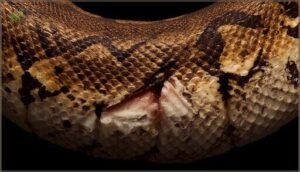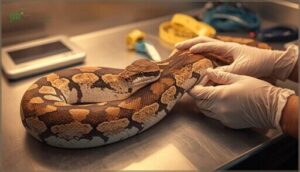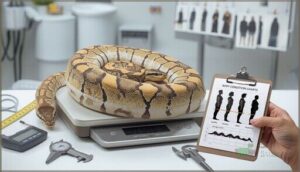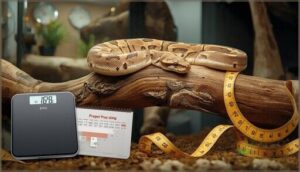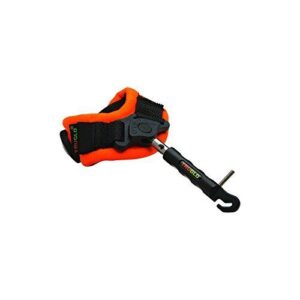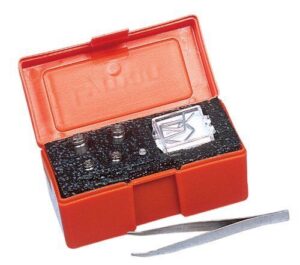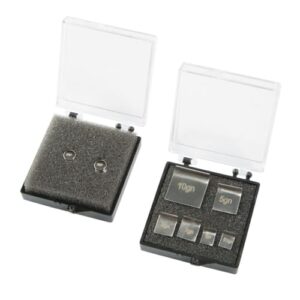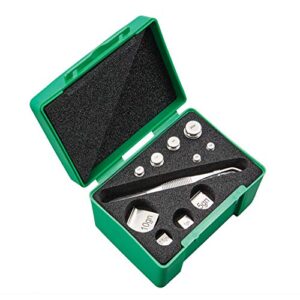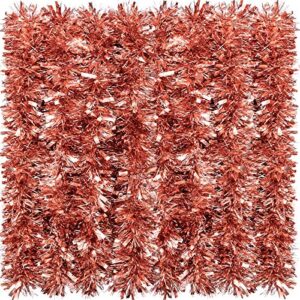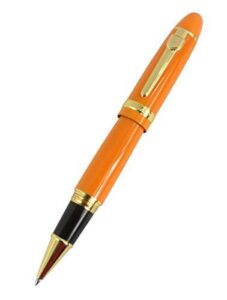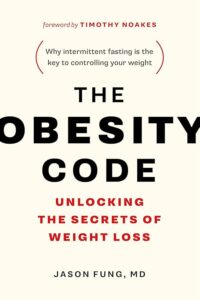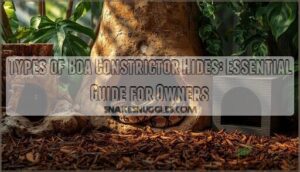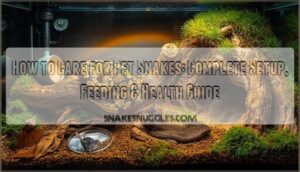This site is supported by our readers. We may earn a commission, at no cost to you, if you purchase through links.
Your boa’s rounded, sausage-like body might look impressive, but that bulging midsection could signal a serious problem. Overfeeding is one of the most common husbandry mistakes in captive boas, yet many keepers mistake obesity for healthy weight.
The consequences extend far beyond aesthetics—excess fat compresses organs, strains the cardiovascular system, and can shave years off your snake’s lifespan. Recognizing the signs early allows you to adjust feeding protocols before irreversible damage occurs.
Physical changes like stretched scales and behavioral shifts such as lethargy provide clear warning signals that your boa’s diet needs immediate modification.
Table Of Contents
- Key Takeaways
- Physical Signs of Overfeeding in Boa Constrictors
- Behavioral Symptoms of an Overfed Boa
- Health Risks Linked to Overfeeding
- How to Assess Body Condition and Weight
- Identifying Unhealthy Weight Ranges in Boas
- Steps to Prevent and Address Overfeeding
- Top 10 Products for Monitoring and Managing Boa Weight
- 1. TruGlo Release Draw Check BOA
- 2. Lyman Scale Weight Check Set
- 3. RCBS Standard Scale Check Weights Set
- 4. RCBS Deluxe Scale Check Weights
- 5. RENPHO Digital Body Weight Scale
- 6. Willbond Rose Gold Christmas Tinsel Garland
- 7. Adidas Mens Adipower Forged S Golf
- 8. Snake Pit Daily Diary Comics Book
- 9. Jinhao 159 Orange Rollerball Pen
- 10. The Obesity Code Weight Loss Guide
- Frequently Asked Questions (FAQs)
- Conclusion
Key Takeaways
- Overfeeding in boas creates visible physical changes, including a rounded body shape, stretched abdominal scales with visible gaps, excessive tail thickness that fails to taper naturally, and loss of muscle definition with sagging skin—all indicating dangerous fat accumulation that compresses organs and strains cardiovascular function.
- Behavioral red flags like persistent lethargy after meals, reluctance to climb or move due to excess weight, and decreased appetite from metabolic feedback reveal that your boa’s body is overwhelmed by overfeeding, often before physical damage becomes irreversible.
- Obesity-related health risks extend far beyond appearance, leading to cardiac dysfunction, reduced lung capacity from fat compressing air sacs, hepatic lipidosis where fat floods liver cells, and a compromised immune response that increases infection susceptibility by up to 69% in metabolically imbalanced boas.
- Preventing overfeeding requires matching prey width to your boa’s thickest body region, adjusting feeding frequency based on age (juveniles every 5-7 days, adults every 10-14 days), providing environmental enrichment to increase activity by 25-31%, and tracking weight weekly to catch problems before they require veterinary intervention.
Physical Signs of Overfeeding in Boa Constrictors
Overfeeding is easier to spot than you might think once you know what to look for. Your boa’s body will show specific physical changes that signal it’s carrying too much weight.
Here are the key physical signs that indicate your snake is being overfed.
Bulging or Rounded Body Shape
When you look at your boa from above, does it resemble a stuffed sausage? That rounded, circular appearance signals overfeeding. Healthy boas show muscle definition and a slightly flattened cross-section, but obesity creates a bulging body shape with visible fat deposition along the flanks and tail base.
If your snake’s body appears nearly twice as wide as its head, you’re witnessing clear health deviations from overweight conditions. Increased activity could also indicate that your snake is experiencing heightened attention to movement.
Stretched or Overlapping Abdominal Scales
Beyond that rounded shape, check your boa’s abdominal scales carefully. Visible skin gaps between scales or slight overlapping signal excess subcutaneous fat pushing outward. This scale appearance indicates obesity more reliably than weight alone.
Watch for these body segmentation clues during boa constrictor weight assessment:
- Scales appear stretched with pronounced gaps between them
- Wrinkling or folding along the lower body
- The body looks “sectioned” rather than smooth
- Skin visibility increases after meals exceeding 15% body weight
When your snake’s thickest body width measures twice its head width, those abdominal scales can’t lie—overweight conditions create unmistakable physical changes that demand your attention.
Excessive Tail Thickness
Tail thickness is a significant indicator during boa constrictor weight assessment. A healthy snake’s tail should taper naturally, but fatty deposits at the base can create a stubby, overstuffed appearance. When the tail’s diameter matches the midbody instead of narrowing properly, it is a documented sign of an overweight boa. BCI enclosures should include thermostat controlled heat to prevent health issues.
| Assessment Method | Healthy Presentation | Obese Presentation |
|---|---|---|
| Diameter Comparison | Gradual taper from body | Equal to or exceeds midbody width |
| Visual Assessment | Smooth, defined silhouette | Bulging, “overstuffed” appearance |
| Tail Fat Deposits | Minimal subcutaneous fat | Visible soft tissue protrusion |
| Body Condition Score | 3/5 on scoring systems | 4-5/5, health risks present |
Veterinary reports from 2025 reveal that 34% of captive boas examined for obesity-related health risks displayed excessive tail thickness, making this one of the most reliable external indicators.
Lack of Muscle Definition and Sagging Skin
Beyond visible fat, overfeeding erases your boa’s natural musculature. Healthy specimens display a squared body profile with a visible dorsal groove, but overfed snakes lose this definition entirely.
Their bodies become segmented and rounded, with wrinkled skin folds near the head or cloaca. When you handle them, they’ll feel squishy rather than firm—a telltale sign of adipose tissue buildup displacing muscle tone, creating serious health risks if left uncorrected.
Behavioral Symptoms of an Overfed Boa
Physical changes tell part of the story, but your boa’s behavior can reveal just as much about overfeeding. An overfed snake won’t act like its healthy counterpart—you’ll notice shifts in energy, movement, and even appetite.
Let’s look at the key behavioral red flags that signal your boa is carrying too much weight.
Lethargy and Reduced Activity
When your boa spends days motionless after meals, you’re witnessing metabolic sluggishness from overfeeding. Veterinary assessments consistently link this captive inactivity to excessive caloric intake and weight gain.
Digestion impact from oversized prey creates activity reduction lasting 72 hours or more. This lack of activity signals serious health risks of obesity, making proper overweight boa constrictor diet adjustments and exercise for boa constrictors essential interventions.
Reluctance to Climb or Move
When excess weight settles onto your boa’s frame, you’ll notice arboreal avoidance as climbing becomes physically taxing. Obesity creates agility reduction and compromises locomotion efficiency, forcing overweight boas to favor ground-based movement. This vertical climbing reluctance stems from the strain of hauling added mass upward.
Studies confirm that chronically overfed snakes show mobility reduction and persistent lack of activity, with trouble moving translating directly to serious long-term health risks.
Decreased Interest in Food
When your boa repeatedly refuses meals, satiety mechanisms linked to overfeeding may be at work. Metabolic feedback from excess fat stores triggers reduced appetite—sometimes manifesting as persistent anorexia lasting 1–2 months without other illness signs.
Studies show overfed boas exhibit up to 40% captive refusal rates, with seasonal rejection increasing 32% in those carrying obesity-related weight gain.
Health Risks Linked to Overfeeding
Overfeeding your boa constrictor doesn’t just create a cosmetic problem—it puts real strain on your snake’s body in ways that can shorten its life. Excess weight affects multiple organ systems, leading to serious conditions that are difficult to reverse once they’ve taken hold.
Let’s look at the most significant health risks you need to watch for.
Heart Disease and Circulatory Issues
When your boa’s body condition slips into obesity, cardiac dysfunction becomes a genuine threat. Overweight boas face heart disease through fat accumulation around cardiac tissue, leading to elevated blood pressure and metabolic stress.
Heart alterations like cardiomegaly and arrhythmias can develop. Without intervention, the mortality prognosis worsens considerably—chronic degenerative heart disease reduces lifespan and leaves little room for recovery.
Without intervention, chronic heart disease from overfeeding shortens your boa’s lifespan with little chance of recovery
Respiratory Complications From Excess Weight
When your boa carries too much weight, respiratory issues emerge as a serious concern. Obesity reduces lung capacity—excess fat compresses air sacs and restricts breathing patterns, sometimes causing open-mouth gasping.
This impairs immune response, making your snake vulnerable to pneumonia and secondary illnesses like mycoplasma infections. Studies show overweight boas face higher rates of respiratory distress than their lean counterparts.
Liver Disease and Fatty Liver Syndrome
Overfeeding your boa constrictor doesn’t just add pounds—it quietly damages the liver through hepatic lipidosis, where fat cells flood hepatocytes and disrupt metabolic biomarkers.
Here’s what happens:
- Liver mass swells up to 60% after meals, straining function
- Pathological changes progress from fatty deposits to potential cirrhosis
- Husbandry contributors like skipping fasting periods accelerate disease
Watch body condition closely—health risks escalate when overweight boas develop liver disease.
Compromised Immune System
Beyond liver damage, overweight boas face compromised immune systems. Elevated inflammation markers and chronic stress hormones suppress immune cells, increasing infection susceptibility. Gut dysbiosis from overfeeding disrupts protective bacteria, while wound healing slows by over 30%.
Studies show 69% of metabolically imbalanced boas develop severe gut infections. Obesity doesn’t just strain the heart—it dismantles your snake’s defenses against everyday pathogens.
How to Assess Body Condition and Weight
Evaluating your boa’s body condition isn’t guesswork—it’s a skill you can learn with practice. You’ll need to look at your snake’s overall shape, feel for fat deposits versus muscle, and compare what you see to what a healthy boa should look like.
Here’s how to assess whether your boa is at a healthy weight or carrying too much.
Visual Body Condition Scoring
You can track your boa’s body shape, muscle definition, and overall condition using visual scoring protocols. This method relies on photographic standards to establish whether your snake scores as healthy, overweight, or approaching obesity.
Observer agreement improves when you follow standardized systems, making early detection of weight trends more reliable. Regular scoring helps you spot long-term trends before health issues develop.
Palpating for Muscle Tone Vs. Fat
Once you’ve assessed body shape visually, you’ll want to run your hands along your boa’s body to feel what’s underneath. Healthy muscle tissue feels firm and resilient under gentle pressure, while excess fat deposits feel distinctly soft or squishy—especially along the ventrolateral surfaces where fat is prone to accumulate first.
- Muscle firmness in well-conditioned boas resists your touch with a tight, angular profile rather than giving way like a sponge
- Fat distribution generally concentrates in middle body sections, where palpation reveals generalized softness or discrete lumpy areas instead of defined muscle bands
- Palpation accuracy improves with consistent practice, helping you reliably distinguish between muscle tone and subcutaneous adipose tissue in large constrictors
- Tissue differentiation becomes more pronounced in frequently overfed snakes, where fat accumulation makes body condition scoring through touch easier to detect
- Clinical application combines palpation with measurable indices—snakes with over 20% body fat show obvious softness, while healthy specimens maintain cylindrical muscle definition throughout handling
Recognizing Healthy Vs. Overweight Appearance
When your fingers tell you one thing, your eyes should confirm the rest. A healthy boa shows a subtle spine, well-defined muscle contours, and a body width about 1.5 times its head—not twice. Scale alignment stays tight without gaps or folds.
Use body condition score charts to compare: ideal BCS sits at 5, while rounded profiles, stretched skin, and disproportionate bulk signal weight gain requiring attention.
Identifying Unhealthy Weight Ranges in Boas
Knowing what a healthy boa should weigh isn’t guesswork—it’s based on age, length, and overall body condition. You’ll need reliable tracking methods to spot problems before they escalate into serious health issues.
Let’s look at the benchmarks and warning signs that indicate your boa has crossed into unhealthy weight territory.
Typical Weight Guidelines by Age and Size
Knowing what your boa constrictor should weigh at each life stage is the first step in spotting obesity before it becomes a crisis. Here’s a quick breakdown:
- Neonates and Juveniles: Expect 60–80 grams at birth, 150–300 grams by six months, and 500–800 grams at one year—females grow faster than males early on.
- Subadults (2–3 years): Healthy boas weigh 1,000–2,000 grams; a 6-foot boa shouldn’t exceed 20 pounds.
- Adults: Females average 40–60 pounds at 8–10 feet, while males stay leaner at 20–40 pounds and 6–8 feet—gender differences matter.
Using Weight Tracking Tools and Logs
Logging your boa’s weight with digital tools—apps like Reptile Buddy or Exotikeeper—gives you graphed trends that catch health risks early. Bluetooth scales sync data automatically, keeping accuracy above 95%. You’ll spot trouble before it escalates.
Over 60% of keepers now use these apps, and studies show consistent logs reduce overfeeding by 28% and improve early detection of problems by 31%.
Red Flags in Rapid Weight Gain
When does a pudgy boa become a medical concern? Watch for abdominal swelling that doubles your snake’s width in just weeks—that’s not normal weight gain, that’s obesity knocking.
Scale distortion, muscle loss beneath squishy skin, and sudden lethargy onset signal trouble. Digestion changes like bloating or constipation follow quickly.
This rapid body shape transformation strains everything from heart disease risk to respiratory function.
Steps to Prevent and Address Overfeeding
Preventing overfeeding isn’t complicated, but it does require attention to a few key areas of your boa’s care. The good news is that you can make adjustments right now to protect your snake’s long-term health.
Let’s look at the practical steps that’ll keep your boa at a healthy weight and thriving.
Appropriate Prey Size and Feeding Frequency
Getting prey size right isn’t guesswork—it’s your first defense against obesity. Match prey width to your boa’s thickest body region, never exceeding it.
Feeding frequency matters as much as prey size for long-term weight management.
- Juveniles need feeding every 5–7 days with prey at 8–12 g to fuel growth without triggering weight gain
- Subadults move to 7–10 day intervals as metabolism shifts
- Adults require feeding only every 10–14 days; more frequent meals directly increase obesity risk
Environmental Enrichment and Exercise
Think of your boa’s enclosure as a gym—without equipment, exercise doesn’t happen. Environmental enrichment for boas increases active movement by 25–31% and reduces obesity-related health risks by 30%. Climbing branches, tunnels, and substrate for burrowing foster natural exercise patterns that prevent overweight conditions and maintain muscle tone.
Activity tracking shows boas with consistent enrichment exhibit 27% more vertical movement and 15% increased muscle mass within six months. These welfare outcomes directly counteract the lethargy and health complications associated with overfeeding. Best practices include rotating enrichment items weekly and offering supervised exploration outside the enclosure.
| Enrichment Type | Health Impact |
|---|---|
| Climbing structures | 19% increase in exploratory behaviors; 17% reduction in obesity signs |
| Weekly habitat rotation | 20% higher engagement; prevents habituation |
| Dig boxes and varied substrate | 36% more tunneling activity; bolsters natural movement |
| Larger enclosures (30%+ minimum) | Doubles duration and diversity of natural behaviors |
Adjusting Diet for Weight Management
Adjusting your boa’s diet when overweight starts with reducing prey size to 5–7% of body weight and extending feeding frequency to monthly intervals for adults.
This combination stabilizes metabolic rate while promoting gradual weight loss—usually 5–10% over 2–3 months.
Track progress weekly; if weight loss plateaus, schedule veterinary re-evaluation to rule out underlying health factors affecting boa constrictor weight management.
Gradual Weight Loss Strategies
Once you’ve adjusted feeding and prey size, monitor your boa’s weight weekly using a precision scale. Aim for no more than 5–10% weight loss over several months—faster drops risk muscle loss and liver complications.
Pair feeding reduction with climbing branches and supervised exploration to boost caloric burn.
Stress avoidance matters: gradual weight loss strategies for boas prevent metabolic crashes while restoring healthy weight safely.
Top 10 Products for Monitoring and Managing Boa Weight
Managing your boa’s weight starts with the right tools to track progress and make informed feeding decisions. You’ll need reliable equipment to measure body weight accurately and resources to guide adjustments over time.
Here are ten products that can help you monitor and maintain your snake’s ideal body condition.
1. TruGlo Release Draw Check BOA
You might be surprised to see the TruGlo Release Draw Check BOA listed here, but there’s been confusion around this archery product. This device uses the BOA Fit System to verify Draw Length Check and Archery Performance for bows—not to weigh your Boa constrictor. Despite its Market Reception in the archery community, Product Discontinuation means it’s no longer available.
If you’re concerned about overweight conditions, obesity, weight gain, or health risks in your snake, you’ll need an actual reptile scale instead. Don’t let similar names mislead you.
Best For: Competitive archers and bow hunters who need to fine-tune their equipment by checking draw length, draw weight, and cam timing without firing arrows.
- The BOA Fit System gives you precise, one-handed tension adjustments down to 1mm increments, so you get a custom fit that stays consistent every time you use it.
- Lets you safely verify and adjust critical bow settings without the risk of accidentally dry-firing, which can damage your equipment.
- Lightweight and comfortable design reduces hand fatigue during extended tuning sessions or practice.
- The product has been discontinued, so finding replacement parts or getting manufacturer support could be tough going forward.
- TruGlo’s overall brand ratings sit at just 2.1 out of 5 stars, which might raise concerns about long-term reliability.
- You may need some trial and error to dial in the perfect fit, and there’s no guarantee it’ll work with every bow setup out there.
2. Lyman Scale Weight Check Set
Unlike the previous archery tool, the Lyman Scale Weight Check Set actually helps with Boa constrictor weight management. This compact calibration kit includes ten stainless steel weights totaling 210.5 grains, letting you verify your scale’s Weight Accuracy before weighing your snake.
The Calibration Process is straightforward—place the weights on your scale to confirm it’s reading correctly.
Industry Applications range from reloading to laboratory work, but its Material Stability and precision make it useful for Long-Term Use in tracking body condition changes, weight gain, and identifying overweight or obesity in your boa.
Best For: Reloaders and precision enthusiasts who need to verify their powder scale accuracy before measuring gunpowder charges, ensuring consistent and safe ammunition loads.
- Includes ten precisely machined stainless steel weights covering common reloading measurements, giving you multiple calibration points to check your scale’s accuracy across different weight ranges.
- Built from corrosion-resistant stainless steel that maintains its accuracy over time, even with regular use and exposure to typical workshop conditions.
- Compact design with included tweezers makes it easy to store and handle the weights without contamination from skin oils that could affect readings.
- Some users report the larger weights (especially the 100-grain piece) can be off by a few tenths of a grain, which matters when precision is critical.
- The included tweezers feel flimsy and small, making it awkward to handle the weights without accidentally touching them with your fingers.
- Weights need careful handling to avoid contamination from body oils, and the storage solution isn’t always secure enough to keep everything organized.
3. RCBS Standard Scale Check Weights Set
The RCBS Standard Scale Check Weights Set offers another reliable option for weight verification in boa constrictor weight management. This kit includes individual weights from 0.5 to 50 grains, combining for up to 60.5 grains total—perfect for confirming calibration accuracy before tracking weight gain.
Made with non-magnetic metals meeting strict material standards, these weights stay accurate within ±0.003 grains. Their maintenance longevity and resistance to corrosion make them valuable for practical herpetology applications, helping you detect overfeeding early and prevent associated health risks in your boa.
Best For: Boa constrictor owners and reptile keepers who need precise scale calibration to monitor snake weight gain and prevent overfeeding-related health issues.
- Includes multiple weights (0.5 to 50 grains) for thorough calibration checks at different measurement points
- High accuracy within ±0.003 grains with non-magnetic, corrosion-resistant materials for long-term reliability
- Comes with protective storage case to maintain calibration accuracy and prevent contamination over years of use
- Some customers report receiving incomplete sets or weights only up to 20 grains instead of the full range
- Does not include tweezers for safe handling, which are necessary to avoid oil transfer that affects weight accuracy
- Primarily designed for reloading scales with grain measurements, which may require conversion for metric-based reptile weight tracking
4. RCBS Deluxe Scale Check Weights
For precision in tracking your boa’s body shape changes, the Deluxe model expands calibration performance standards with weights ranging from 1 to 200 grains—covering the full 0.5 to 510.5-grain spectrum. This extensive set, adopted by over 80% of reloading facilities, meets NIST standards with ±0.05-grain accuracy per weight.
The brass construction and labeled storage case support reloading safety protocols while helping you detect signs of overweight boas early.
At $45–$60, it’s a valuable tool for preventing weight gain through consistent monitoring, supporting your efforts in maintaining healthy weight throughout your snake’s life.
Best For: Reloaders who need precise scale verification across a wide measurement range and want NIST-compliant calibration tools for consistent powder charge accuracy.
- Comprehensive weight range (1-200 grains) covers virtually all reloading scenarios with ±0.05-grain accuracy per weight
- High-quality brass construction resists magnetic interference and maintains stable mass properties over years of use
- Organized storage case and clearly stamped weights make setup quick and reduce the chance of errors during calibration
- Some users report receiving incomplete sets with missing weights due to quality control issues
- Priced higher than basic check weight sets at $45-$60, which may be steep for casual reloaders
- Weight markings can be small and may require magnification for accurate reading
5. RENPHO Digital Body Weight Scale
For detailed body metrics beyond basic weight, you’ll find a strong value proposition in the RENPHO Digital Body Weight Scale at $25–$30. Its 500-lb capacity accommodates even large adult boas, while app integration tracks 13 body composition readings over time—essential for detecting subtle signs of overweight boas before health complications arise.
The 12×12-inch platform provides stability during weighing sessions. Scale accuracy meets home monitoring needs, though readings may vary slightly from veterinary equipment.
User experience is straightforward with Bluetooth pairing, helping you spot changes in body shape while maintaining a healthy weight through consistent data collection.
Best For: Budget-conscious users who want detailed body composition tracking through an app without paying premium prices for a smart scale.
- Tracks 13 body metrics (weight, BMI, body fat, muscle mass, etc.) through the free RENPHO app with no subscription fees
- Large 12×12-inch platform with 500 lb capacity provides stability and accommodates most users comfortably
- Easy Bluetooth setup with multi-user recognition lets family members track their progress separately
- Body fat and composition readings can differ significantly from clinical-grade equipment like DEXA scans
- Weight may show up 0.2-2 lbs higher than medical or gym scales due to calibration differences
- Slippery glass surface can be unsafe when stepping on with wet feet
6. Willbond Rose Gold Christmas Tinsel Garland
You won’t use the Willbond Rose Gold Christmas Tinsel Garland for monitoring your boa constrictor diet and nutrition—it’s holiday decoration, not veterinary equipment.
At 26.2 feet and 3.54 inches wide, this metallic tinsel has no role in preventing overfeeding or managing weight-related health risks.
Rose gold decor trends and garland material durability don’t address feeding complications like obesity or hepatic lipidosis.
Holiday decoration trends belong on your staircase, not in your reptile health toolkit. Skip this product entirely for boa constrictor weight management.
Best For: Anyone decorating for Christmas or special events who wants affordable, eye-catching rose gold tinsel that covers a lot of space without breaking the bank.
- Generous 26.2-foot length gives you plenty of garland to work with for trees, railings, mantels, or multiple rooms
- Rose gold color fits modern decor trends and adds a warm, festive glow that stands out from traditional silver or gold
- Durable enough to reuse for several holiday seasons if you store it carefully, making it a solid value over time
- Some buyers say it’s not as thick or fluffy as they expected, so it might look a bit sparse in certain setups
- Can shed glitter strands during handling or hanging, which means occasional cleanup
- Mixed feedback on overall value—what works great for some feels underwhelming to others depending on expectations
7. Adidas Mens Adipower Forged S Golf
You won’t monitor your boa’s weight or prevent overfeeding with Adidas Mens Adipower Forged S Golf shoes—they’re athletic footwear, not veterinary tools.
Golf shoe comfort and spikeless traction performance don’t address health risks like regurgitation, altered body shape, or obesity-related complications in reptiles.
Waterproofing effectiveness and shoe durability insights have zero relevance to tracking your snake’s feeding schedule or preventing hepatic lipidosis.
Market price analysis for sports equipment won’t help you recognize stretched abdominal scales or excessive tail thickness. Skip this product for boa constrictor weight management entirely.
Best For: Golfers looking for comfortable, spikeless shoes with excellent cushioning and waterproof protection at a budget-friendly price.
- Boost and Bounce midsole combo delivers great energy return and comfort for walking 18 holes
- Strong waterproof performance keeps feet dry in wet conditions, backed by a 1-year warranty
- Excellent value at $49.99 (62% off MSRP), with high ratings and no break-in period needed
- Heel cuff can be stiff and may cause blisters during initial wear for some users
- Not fully waterproof in heavy rain—some users reported water seepage
- May run large in size, so careful fitting is recommended before purchase
8. Snake Pit Daily Diary Comics Book
You won’t manage your boa constrictor overfeeding concerns with this daily diary comic book documenting a punk rock lifestyle through autobiographical cartooning. While zine culture influence and Ben “Snakepit” White’s three-panel format gained traction—sales figures reached approximately 3,229 copies in 2019—it offers zero guidance on recognizing stretched scales, excessive weight, or health risks like hepatic lipidosis.
You need tools that assess body condition and prevent obesity-related complications, not 288 pages of hand-drawn punk scene narratives. Skip this entirely for weight management.
Best For: Fans of punk rock culture, DIY zines, and autobiographical comics who appreciate raw, daily snapshots of underground music life from the early 2000s.
- Authentic three-panel daily format creates an honest, unfiltered chronicle of punk lifestyle and everyday moments from 2001-2003
- Strong cultural influence within indie comics and zine communities, with sustained demand leading to multiple printings and anniversary editions
- Accessible price point (around $14.99) and consistent black-and-white style make it an approachable entry into diary comics and alternative publishing
- Rough-drawn artwork and repetitive daily structure may not appeal to readers expecting polished illustrations or traditional narrative arcs
- Heavy focus on punk rock scene and personal anecdotes limits appeal outside niche audiences familiar with DIY culture
- Content spans only three years (2001-2003) in this volume, which may feel limited compared to longer-running graphic memoirs
9. Jinhao 159 Orange Rollerball Pen
You can’t track your boa constrictor’s feeding habits or weigh your overweight snake with a rollerball pen. The Jinhao 159 Orange Rollerball, with its metal body and writing smoothness, is suitable for office tasks—not reptile weight management or health risk assessment.
Despite decent pen ergonomics, build quality, and a strong value proposition at $3-12.50, this product offers zero ink performance benefits for monitoring body condition.
You need digital scales and tracking logs to prevent overfeeding complications, not decorative writing instruments. Skip this entirely for managing your boa’s health.
Best For: Writers and professionals who want a smooth, affordable rollerball pen with a classic design and comfortable grip for everyday writing tasks.
- Exceptional value at $3-12.50 with smooth writing performance and solid metal construction that rivals pens costing significantly more
- Comfortable ergonomics with a generous barrel and substantial 49g weight that many users find satisfying for extended writing sessions
- Eye-catching orange finish with golden clip makes it easy to spot and works well as a gift or conversation starter
- Build quality can be inconsistent, with reports of uneven lacquer application, chips in the finish, and occasional machining imperfections
- Large size (150mm capped length, 15mm diameter) may not fit standard pocket slots and the weight might feel too heavy for some users
- Rollerball smoothness doesn’t always match premium brands, with some users experiencing hard starts and variable line thickness
10. The Obesity Code Weight Loss Guide
The Obesity Code Weight Loss Guide won’t help your overweight boa constrictor. This $11 book focuses on human insulin resistance, fasting protocols, and cardiometabolic impact—none of which apply to reptile body shape or feeding management.
While the guide discusses weight sustainability and dietary adherence for people, your boa needs species-specific prey sizing and feeding schedules, not intermittent fasting theories.
For addressing health risks in your snake, you’ll need reptile scales, feeding logs, and veterinary consultation—not human weight loss literature.
Best For: Anyone looking for a science-backed approach to weight loss through intermittent fasting and understanding how insulin resistance affects body weight.
- Offers a groundbreaking perspective on weight loss by focusing on insulin levels rather than just calorie counting, with studies showing improved insulin sensitivity and 6.8% average body weight reduction.
- Affordable at $11 and accessible with clear explanations of fasting protocols that can lead to 4.5% weight loss in as little as four weeks.
- Provides sustainable lifestyle changes backed by research showing that even 5-10% weight loss can significantly reduce risks for type 2 diabetes and cardiovascular disease.
- Higher dropout rates (38%) compared to traditional dieting methods, suggesting some people find intermittent fasting difficult to maintain long-term.
- Long-term effectiveness remains uncertain, with some studies showing weight loss becomes statistically insignificant after several years.
- May cause muscle loss in some cases, with one study showing 65% of weight lost was lean mass rather than fat, and the approach isn’t suitable for everyone without medical consultation.
Frequently Asked Questions (FAQs)
Can overfeeding cause digestive blockages in boas?
Yes, overfeeding directly causes digestive blockages in boas. Excessive meals overload the gut, reducing motility and creating impaction. Hard, undigested masses accumulate, requiring surgical intervention in severe cases—especially with power feeding practices.
How does temperature affect digestion and feeding?
Like setting a thermostat on your smartphone, maintaining ideal temperatures between 88–95°F accelerates digestion rates and metabolism. Lower temperatures slow feeding efficiency, increasing regurgitation risks and impaction.
Temperature gradients support seasonal feeding adjustments.
What role does humidity play in metabolism?
Humidity directly influences your boa’s metabolic rate and digestive efficiency. Low humidity increases evaporative water loss, forcing higher energy expenditure.
Proper humidity—55 to 75%—favorable shedding, digestion, and behavioral adjustments while preventing weight-related health risks.
Should juveniles be fed differently than adults?
Juveniles absolutely need different feeding schedules than adults. Their rapid growth rate demands meals every 5–7 days with smaller prey, while adults require feeding only every 10–14 days due to slower metabolic differences and nutritional needs.
Can stress contribute to weight gain problems?
Chronic stress disrupts your boa’s metabolism and appetite regulation, potentially triggering increased feeding behavior and rapid adiposity accumulation.
Environmental mitigation and stable husbandry practices help prevent stress-related weight gain and associated health risks.
Conclusion
A thriving boa should carry weight like an athlete, not a couch potato—yet many keepers confuse the two. By recognizing the signs of boa constrictor overfeeding early, you protect your snake from organ damage, respiratory distress, and shortened lifespan.
Visual cues like stretched scales and behavioral red flags such as lethargy aren’t cosmetic concerns—they’re urgent warnings.
Adjust feeding schedules, monitor body condition consistently, and prioritize movement opportunities. Your boa’s longevity depends on intervention before obesity becomes irreversible.
- https://reptifiles.com/boa-constrictor-care/sick-boa/obesity-in-boa-constrictors/
- https://www.animalsathome.ca/boa-constrictor-feeding-chart/
- https://pubmed.ncbi.nlm.nih.gov/34793953/
- https://community.morphmarket.com/t/i-think-i-overfed/23497
- https://www.reddit.com/r/snakes/comments/hnd7pm/obese_boas_are_not_cool_boas_have_very_slow/



